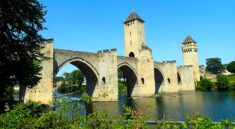
We’d just finished a great few days site seeing in Evora and really enjoyed the amazing Roman history. We’d discussed moving onto Lisbon but only one of us was feeling the love for Lisbon and the bustle of the big city. However, just 100 miles to the East of Evora, back into Spain was the small city of Merida, the capital of Western Spain’s Extremadura region.
Merida was founded by the Romans in the 1st century B.C. and it preserves more important ancient Roman monuments than any other city in Spain. That was enough for us to detour out of Portugal and back into Spain for a couple of days. We both LOVE Roman history and ruins.
The original town was founded in 25 BC, with the name of Emerita Augusta, which means the veterans – discharged soldiers – veteran legionaires of the army of Augustus, who founded the city. The name Merida is an evolution of this. Emperor Augustus ordered that a pass and a bridge over the Guadiana river be protected. Emerita Augusta became one of the most important cities in the Roman Empire. It was at one end of the Dia de la Plata (Silver Way), while at the other end was the gold mines around Asturica Augusta.
National Museum of Roman Art
Our photos of the museum really don’t do it justice. Although photos were allowed, flash is not, and as with all museums, it’s not too brightly lit to protect the exhibits. You’ll just have to imagine the bright colors in the mosaics and the bright white of the marble statues.
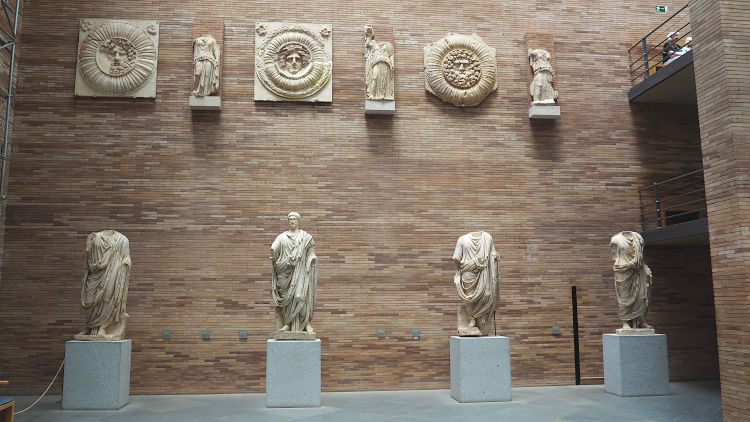
We decided to begin our tour of Merida at the museum so we would get a good overall picture of how important Merida was. We weren’t disappointed. What an excellent display of history in a very light and modern way. The displays were both very educational and interesting.

The museum was massive in terms of its size, particularly its height which allowed it to house a very tall column. It has three floors and a Crypt, with the top two open floors allowing you to see down on some amazingly big exhibits. It’s only by being so huge and so open that they can effectively display the size of the artefacts, the columns and the massive mosaic floors which are mounted on the walls.

Throughout the bricked wall museum there were lots and lots of statues (sculptures), busts (head or head and shoulders) and huge mosaics that were originally decorative floors. There were also incredible reliefs (ceiling moulding), cornices, massive lintels and grave markers. If it can be carved or sculpted from stone or marble, it was there.

If you want to see some of the more impressive exhibits at the Roman museum then click here to see the slide show. Again, photos aren’t great…
These original items were taken from the many archaeological digs that had been carried out over the centuries at Merida. At the Roman sites around the city, original items that were in the museum were replaced by modern copies, reproductions of the older pieces.

We then went down under the museum to The Crypt. When they were building the foundations of the museum they found several Roman houses, graves and a road. The porticoed patios and murals of the houses were particularly striking. There was an incredible amount of history just there underneath the museum.

At one stage we spotted 7 or 8 large pieces of mosaics that had been removed and were just leaning up against one of the pillars holding up the museum. There was no padding or anything put between them. We would have loved any one of those in our house! Wouldn’t it make an amazing feature on the wall, to have a piece of ancient Roman floor mosaic to display? Maybe one day, if we get a house of our own, we will make a reproduction.
Roman Theatre

The Roman Theatre was built in the years 16 to 15 BCE, by Marcus Agrippa, Roman general and son-in-law of Caesar Augustus. The theatre underwent renovations at the end of the 1st century or early 2nd century CE when the elaborately decorated architectural background was erected. It underwent further renovations between 330 and 340 AD which introduced new decorative-architectural elements and a walkway around the monument.

The semicircular shape of the grandstands is incorporated into the gradient of San Albin hill. In its time it had a seating capacity of 6,000. The diameter is about 280 feet. The stands are divided into three areas. Pretty much the rich and important citizens sit at the front and the riff-raff at the back. Six doors at the top give access to a corridor covered by a semicircular dome ring that serve as entry and exit doors at the two extremities. In total, thirteen outside doors facilitate access and entrance to the theatre.
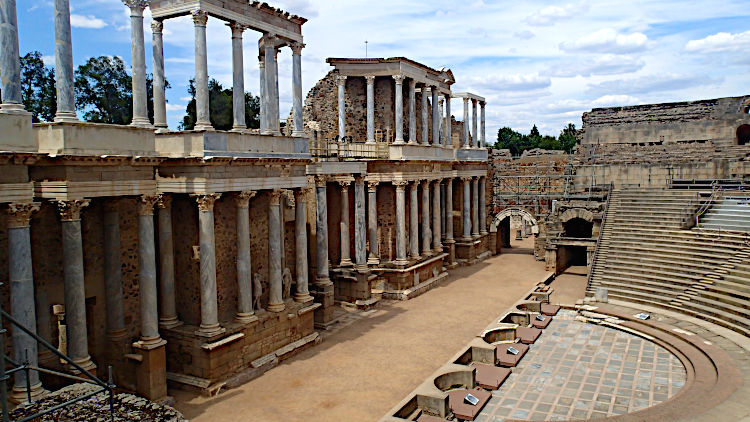
The seating capacity today is 3,000 and every summer during July and August the theatre’s acoustics still echo throughout the city during Theatre Festival. Events include Greek dramas, tragedies, comedies, musicals, and dance shows. The Theatre was extensively rebuilt from the 1930s to the 1970s.
Roman Amphitheatre

The Roman Amphitheatre of Merida was opened in the year 8 BC. Like the Theatre next door, the Amphitheatre makes use of the slope of the hill of San Albin.

The stands had a seating capacity of approximately 15,000 spectators and had supporting stairs and hallways that connected the different parts internally. The amphitheatre is built in an elliptical shape as normal, while the sand-covered arena in the centre had a Fossa Bestiaria, which was covered with wood and sand. This Fossa was used to house animals before they were released into the arena.
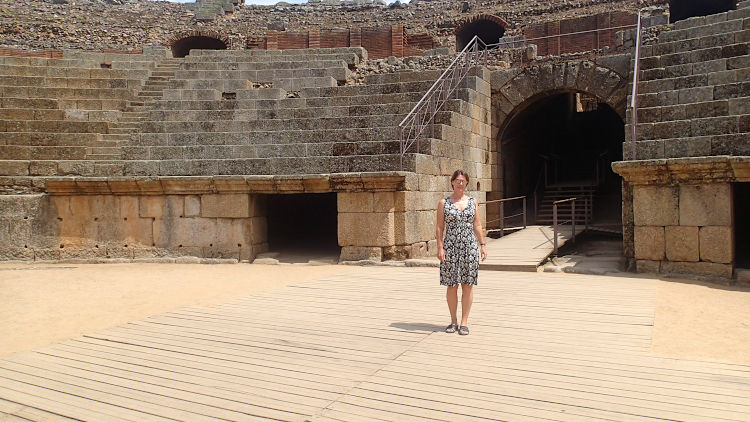
The Amphitheatre served as the setting for very popular shows: the games of gladiators, hunts of wild beasts, and the struggle between wild animals in artificial settings recreating forests, jungles with lakes, or deserts.
Roman Circus

The Roman Circus of Merida was used for chariot racing and it was modelled on the Circus Maximus in Rome and other circus buildings throughout the empire.
It seems to have been built sometime around 20 BC and inaugurated some 30 years later. It measures more than 1300 feet in length and is over 100 feet wide and would have been able to house up to 30,000 spectators.

It is one of the best-preserved examples of a Roman circus and we can vouch for that, as we have seen quite a few. It is much better than the Circus Maximus in Rome. Most Circus structures have been destroyed over time as the area occupied by them was great and often in very flat land near their respective cities. There is never much left of these and most of the time you just get to see a third or a half of it. This one in Merida is complete, although obviously there is never much left of the stands where the spectators would have sat.

After the fall of the Western Roman Empire and the rise of Christianity in Spain, the circus saw more use than the other Roman structures of Merida. This was because racing was considered less sinful than spectacles performed in the Theatre or Amphitheatre.
Roman Bridge (Puente Romano)

The Roman Bridge of Merida spans the Guadiana River, and it’s LONG! See it disappearing into the distance behind Deb? Its three times as long as you think, because that’s not the other bank of the river you can see, that’s an island in the middle of the river; the bridge carries on far past that into the distance.
It is the world’s longest (in terms of distance) surviving bridge from ancient times. It once featured an estimated overall length of 755 metres with 62 spans, although today it is just a little shorter as there are 60 spans (three of which are buried on the southern bank because of silting of the river bank) with a length of 721 metres.

It is still in use today but was pedestrianized in 1991 as road traffic was redirected to use the nearby Lusitania Bridge, thereby preserving it for many generations to come.
Roman Temple

The Roman Temple of Diana was part of the main municipal forum of Merida (the city was so big it actually had two forums). It is one of the few Roman religious monuments that has been preserved in such good condition.

Despite its name as Temple of Diana, this temple was used for imperial cult (worship of Emperor Augustus) and was built in the late 1st century BC. Roman Emperors were seen as Gods and temples were often built in their honour.
The rectangular base of the building is surrounded by columns and has a hexastyle on the front ie. six front facing columns. The whole structure is elevated on a base. It is thought that a garden with a pond existed beside the temple. Two deep pools remain on the sides of the temple today.
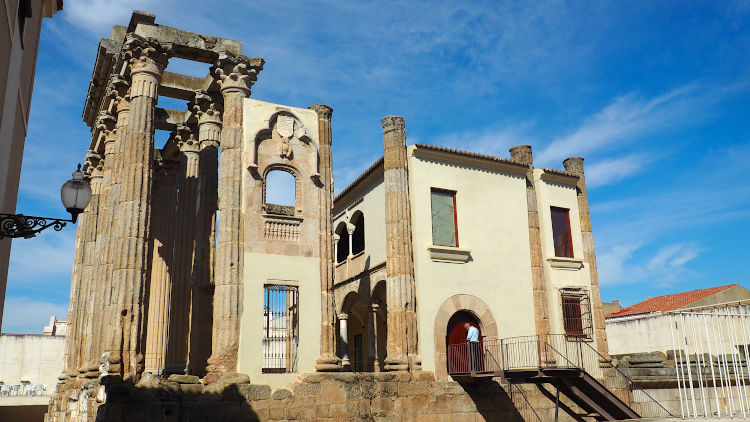
In the 16th century and taking as its base the structure of the temple, the palace for the Duke of Corbos was built. This is one of the main reasons that the Temple has been preserved in such good condition today. During the latest conservation efforts for the Temple, it was decided to leave some of that building in place. It has a historical interest in itself and is majorly responsible for the temple being preserved over recent centuries.
Trajan’s Arch

The Trajan Arch of Merida has in the past been said to have been a triumphal arch to Emperor Trajan. However, this has been cast into doubt and historians now think it much more likely that it was an entry gate to the nearby Temple of Diana. The Temple is directly ahead of the gate along one of the main streets through the city. The doorway was comprised of three arches, however, only the central one remains today and the door is long gone.

A rounded, fifteen-metre high arch made of granite and probably once lined with marble, the Trajan Arch of Merida is inconspicuously located on a normal pedestrian street. In its time it stretched over the city’s most important street- the Cardo Maximus. The present street level is around 6 feet higher than in Roman times, so the street is cut away at the point of the arch, to reveal the original Roman road and pavement beneath, and the two smaller pedestrian gates through the original city wall.
Roman Aqueduct
There were actually three Roman Aqueducts in Merida, two above ground and one fed by underground tunnels.
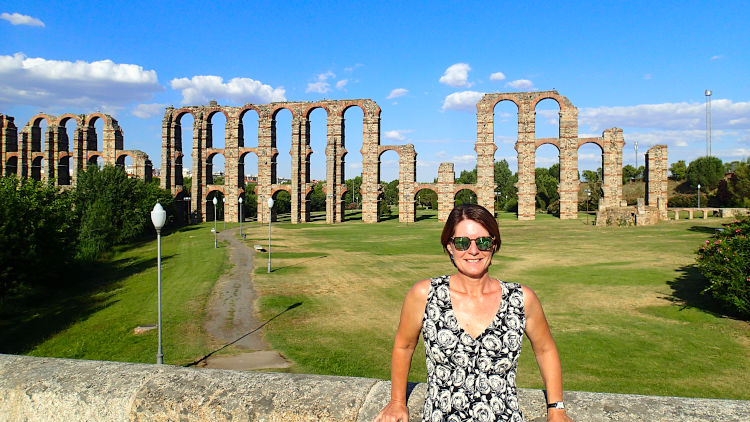
The most famous one and the most striking remains today is the Acueducto de los Milagros (Miraculous Aqueduct).
Only a relatively small stretch of the aqueduct still stands, consisting of 38 arched pillars standing 82 feet high along a course of some 2,700 feet. It is constructed from finely dressed granite blocks interspersed with red brick. The structure originally brought water to the city from a reservoir around 3.1 miles to the north-west of Merida.

It is thought to have been constructed during the 1st century AD, with a second phase of building (or renovations) around 300 AD. In later centuries, the inhabitants of Merida dubbed it the “Miraculous Aqueduct” for the awe that it evoked.
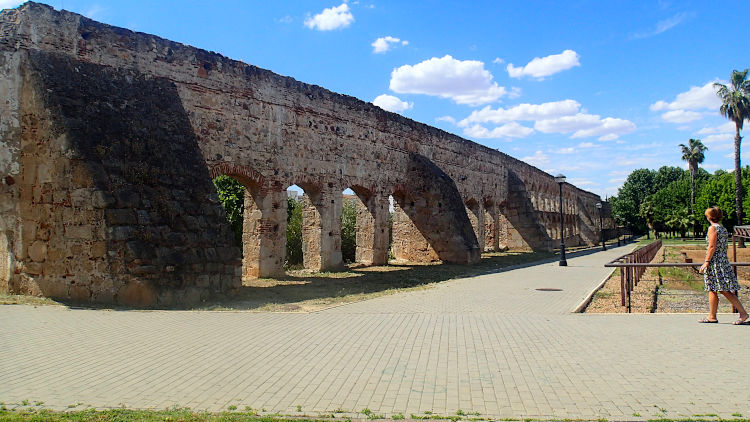
We did see the other aqueduct – The Aqua Augustus – which is above ground when we were visiting the Roman Circus. It’s not so finely built or tall as it comes into a lower part of the city. Next to it is a small but badly ruined bathhouse.
Roman House Of Mithraeum

What an amazing place this is. It has so far only been partially excavated. The visible remains (so far) occupy a surface area of 2,049 square metres, corresponding to the house and the private baths. They’ve only so far come to one edge of the house, the main entrance where it joins the street, so who knows how huge it could be when they reach the outside on all sides.
The residence was built at the end of the first century AD outside the walls of Merida, where the city extended amongst handicraft facilities and tombs. The whole dwelling was built on a gentle hillside, spread over three terrace levels, each one containing a central patio. The latest changes/upgrades to the house were carried out in the 4th century AD.
The whole site is open air with a cover over to protect it.

One of the rooms preserves the mosaic of the Cosmos (seen above and detail below). It represents a colourful and realistic mixed group of human figures that represent the different elements of the known universe, going from terrestrial and marine elements until celestial elements, but they all revolve around the essential figure of Eternity (Aeternitas).

It’s probably the most intricate, detailed and impressive mosaic panel we’ve seen. The striking blue color is prefect and there are metallic elements of gold in the halos, and jewelry worn by the figures. It is truly magnificent and must have been a joy to the owners in its day.

The name given, Mithraeum House is a recent one. During the excavation works of the bullring in 1903 they found marble statues relating to Mitra, a god of Persian origin, greatly worshiped by the Roman troops. Mistakenly the house was taken as a temple devoted to this god and hence it is known by that name.
This magnificent mansion surely must have belonged to an important person of the Roman social elite of Merida. The house is absolutely huge and it had its own personal private baths.

Something original that we have never seen anywhere else in a Roman house was summer bedrooms. In the hot summers that Merida has this house had two bedrooms that were below ground level – to help keep its occupants cool. How amazing! We’ve never seen a Roman house with a full basement before, but from one of the courtyards, there are stairs down to a short corridor leading to two underground rooms with high windows for some light and ventilation. Perfect for keeping cool on those hot summer nights in the city.
If you want to see more photos of the remains of the house and the mosaics, there are some much better photos on this site. Check them out. It’s a very impressive house and worth going out of your way to see it (if you love Roman stuff).
http://ancientworld.hansotten.com/spain/merida-emerita-augusta/merida-mithraeum-house/
Entrance ticket info
As far as how much everything cost, lots were free like the Roman Bridge, Temple, Arch, Aqueducts while the Museum was a very reasonable €3. For the Roman Theatre, Amphitheatre, Circus, Mithraeum House we paid a multi-entry ticket fee of €15. This also included entry to other places that we visited – The Alcazaba (9th Century Moorish fort), the Crypt of the Santa Eulalia Church (birthplace of Christianity in Merida), Funeral Area of the Columbarios (Mausoleum and burial grounds).
So we absolutely loved Merida. Driving 100 miles out of Portugal and into Spain and then back again was well worth it. It’s a Roman gem!

